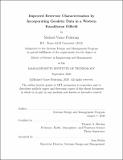| dc.contributor.advisor | Thomas A. Herring. | |
| dc.contributor.author | Pickering, Michael Vance. | en_US |
| dc.contributor.other | Massachusetts Institute of Technology. Engineering and Management Program. | en_US |
| dc.contributor.other | System Design and Management Program. | en_US |
| dc.coverage.spatial | a-kz--- | en_US |
| dc.date.accessioned | 2021-10-08T16:59:24Z | |
| dc.date.available | 2021-10-08T16:59:24Z | |
| dc.date.copyright | 2020 | en_US |
| dc.date.issued | 2020 | en_US |
| dc.identifier.uri | https://hdl.handle.net/1721.1/132853 | |
| dc.description | Thesis: S.M. in Engineering and Management, Massachusetts Institute of Technology, System Design and Management Program, September, 2020 | en_US |
| dc.description | Cataloged from the official version of thesis. | en_US |
| dc.description | Includes bibliographical references (pages 135-139). | en_US |
| dc.description.abstract | Reservoir characterization for petroleum systems stands as a key source of competitive advantage amongst operators. Exploration and field development activities require large investments of engineering time and capital to be made in pursuit of improved short- and long-term economic decision-making posture. For this reason, identifying workflows from adjacent earth science fields of study to tackle reservoir characterization challenges is of utmost importance. Examined in this thesis is the idea of whether improved reservoir characterization can be a corollary of the modern advancements in geodesy. This thesis proposes a holistic workflow to improve subsurface reservoir characterization using commercially available tools and insights by incorporating modern Interferometric Synthetic Aperture Radar (InSAR) geodetic data to better inform model assumptions. Surface deformation measurement by InSAR is used to provide subsurface insights using as an example the "Polygon" field in Kazakhstan. This workflow leads to several key conclusions which could only be realized traditionally by drilling additional exploratory wells to collect the necessary data. Firstly, early seismic field work identified the presence of several faults which divide the area of study into three distinct blocks, which were assumed to be impermeable at the boundaries. However, due to the flow directions and rock deformation observed in the simulated reservoir and geomechanical models, only one of the three blocks exhibits "compartmentalization," or impermeable bounding at the faults. With a displacement of 20 meters at the fault faces, expected permeability values for these fault boundaries were anticipated to be less than 1 millidarcy of permeability; however, permeability above 1 Darcy exists across two of the three block fault boundaries. The geomechanical model of the reservoir predicts subsidence at surface while InSAR shows localized uplifts of several centimeters on the western and eastern edges of the studied blocks. The only way to match the subsurface geomechanics model with the directly measured InSAR is to implement a no-flow boundary at the eastern fault that delineates the westernmost block. As a result, a strategy for improved recovery efficiency from the western compartmentalized block is proposed to enhance pressure maintenance and improve waterflood effectiveness. Also, further geomechanical and InSAR comparison suggests the presence of a weak edge aquifer influx behavior in the area of study flowing north to south. In summary, the combination of reservoir simulation, geomechanical modelling, and direct InSAR measurement represents a significant opportunity for improving reservoir characterization using readily available techniques at an incrementally low cost. | en_US |
| dc.description.statementofresponsibility | by Michael Vance Pickering. | en_US |
| dc.format.extent | 139 pages | en_US |
| dc.language.iso | eng | en_US |
| dc.publisher | Massachusetts Institute of Technology | en_US |
| dc.rights | MIT theses may be protected by copyright. Please reuse MIT thesis content according to the MIT Libraries Permissions Policy, which is available through the URL provided. | en_US |
| dc.rights.uri | http://dspace.mit.edu/handle/1721.1/7582 | en_US |
| dc.subject | Engineering and Management Program. | en_US |
| dc.subject | System Design and Management Program. | en_US |
| dc.title | Improved reservoir characterization by incorporating geodetic data in a western Kazakhstan oilfield | en_US |
| dc.type | Thesis | en_US |
| dc.description.degree | S.M. in Engineering and Management | en_US |
| dc.contributor.department | Massachusetts Institute of Technology. Engineering and Management Program | en_US |
| dc.identifier.oclc | 1263245122 | en_US |
| dc.description.collection | S.M.inEngineeringandManagement Massachusetts Institute of Technology, System Design and Management Program | en_US |
| dspace.imported | 2021-10-08T16:59:24Z | en_US |
| mit.thesis.degree | Master | en_US |
| mit.thesis.department | SysDes | en_US |
